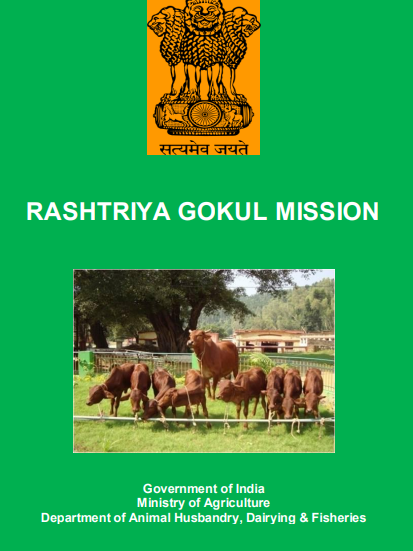Rashtriya Gokul Mission 22/06/2019 – Posted in: Press Information Bureau – Tags: department of animal husbandry dairying & fisheries, gokul gram
Rashtriya Gokul Mission
(Ministry of Fisheries, Animal Husbandry & Dairying)
WHAT
Funds have been endorsed under Rashtriya Gokul Mission for setting up of 21 Gokul Grams as Integrated Cattle Development Centers.
RASHTRIYA GOKUL MISSION (RGM)
RGM has been launched in 2014 for the conservation and development of indigenous breeds through selective breeding in the breeding tract and genetic upgradation of the nondescript bovine population.
The scheme comprises two components namely the National Programme for Bovine Breeding (NPBB) and National Mission on Bovine Productivity (NMBP).
OBJECTIVES OF RGM
- Development and conservation of indigenous breeds.
- Breed improvement programme for indigenous breeds so as to improve the genetic makeup and increase the stock.
- Enhancing milk production and productivity of the bovine population by increasing disease-free high genetic merit female population and check on the spread of diseases.
- Upgrading nondescript cattle using elite indigenous breeds like Gir, Sahiwal, Rathi, Deoni, Tharparkar, Red Sindhi.
- Distribution of disease-free high genetic merit bulls for natural service.
- To bring all breedable females under organised breeding through AI or natural service using germplasm of high genetic merits.
- To arrange quality Artificial Insemination (AI) services at farmers’ doorstep.
- To create an e-market portal for bovine germplasm for connecting breeders and farmers.
- To increase the trade of livestock and livestock products by meeting out sanitary and phytosanitary (SPS) issues.
- To select breeding bulls of high genetic merit at a young age through the application of genomics.
GOKUL GRAM
The Rashtriya Gokul Mission also envisages the establishment of integrated cattle development centers‘ Gokul Grams’ to develop indigenous breeds including up to 40% nondescript breeds.
- To promote indigenous cattle rearing and conservation in a scientific manner.
- To propagate high genetic merit bulls of indigenous breeds.
- To optimize modern Farm Management practices and promote Common Resource Management.
- To utilize animal waste in economical way i.e. Cow Dung, Cow Urine
The Gokul Gram will be self-sustaining and will generate economic resources from the sale of A2 milk, organic manure, vermicomposting, urine distillates, and production of electricity from biogas for in house consumption and sale of animal products.
The Gokul Gram will also function as state of the art in situ training centre for Farmers, Breeders and MAITRI’s.
IMPLEMENTATION OF RGM
- The mission will be implemented through the “State Implementing Agency (SIA viz Livestock Development Boards).
- State Gauseva Ayogs will be given the mandate to sponsor proposals to the SIA’s (LDB’s) and monitor implementation of the sponsored proposal.
- All Agencies having a role in indigenous cattle development will be the “Participating Agencies” like CFSPTI, CCBFs, ICAR, Universities, Colleges, NGO’s, Cooperative Societies and Gaushalas with the best germplasm.
Bovine Stocks: There are 26 well defined breeds of cattle in India, constituting around 18 percent of the country’s total cattle population. The remaining 82 percent of the cattle are referred to as nondescript and are generally named after the region they come from. For optimal productivity of the animal, attention should be paid to the breeding partners, which should possess good characteristics such as high milk yield. This is often not done.
Source: PIB
You can follow us on LinkedIn and on Instagram (Diligent IAS) for more updates related to IAS Preparation/ Study Material, Subscribe to our Facebook Page and Youtube Channel- Diligent IAS

